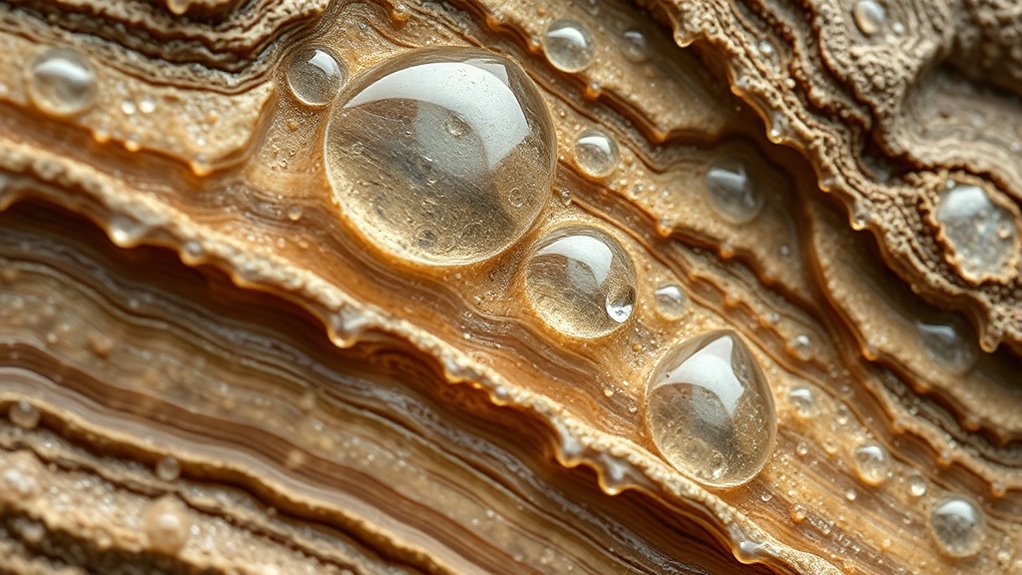Fossilized raindrops help you understand Earth’s early climate by revealing how rainfall and atmospheric conditions were in ancient times. When these raindrops impact soft surfaces, they create features that can be preserved through mineralization, protecting key clues about past environments. Analyzing their shape, composition, and isotopic signatures lets you reconstruct ancient weather patterns and climate fluctuations. If you explore further, you’ll discover how scientists interpret these fossils to unearth Earth’s climatic history.
Key Takeaways
- Fossilized raindrops preserve impact features and surface textures that reveal past atmospheric conditions.
- Chemical and isotopic analyses of these fossils reconstruct ancient rainfall patterns and climate variability.
- Their mineral composition and microstructures provide insights into Earth’s early atmospheric composition and temperature.
- Comparing fossilized raindrops across different periods uncovers long-term climate changes and regional weather shifts.
- Advances in microscopy and geochemical techniques improve accuracy in interpreting ancient climate signals from these fossils.
The Formation and Preservation of Fossilized Raindrops

The formation of fossilized raindrops begins when raindrops strike soft, mud-rich surfaces during a storm, creating impact marks that can later be preserved. Raindrop morphology influences the shape and size of these impact sites, which are essential for identifying fossilized rain. As the impact occurs, fossilization processes start, involving rapid burial by fine sediments that protect the marks from erosion. Over time, mineralization replaces organic components, solidifying the impression into a durable fossil. The preservation depends on environmental conditions like low oxygen levels and rapid sedimentation, which help maintain the integrity of the impact features. Additionally, the use of natural materials such as stone and wood in the surrounding environment can contribute to the fossilization process by providing additional protection and mineral sources. Understanding these processes allows scientists to interpret ancient rainfall patterns and climate conditions based on the morphology of fossilized raindrops.
Analyzing Composition to Reconstruct Ancient Atmospheres

By analyzing the chemical signatures in fossilized raindrops, you can uncover clues about Earth’s ancient atmosphere. Isotopic compositions reveal details about past climate conditions and atmospheric chemistry. These insights help you reconstruct how our planet’s environment has changed over millions of years. Utilizing vetted scientific methods ensures the accuracy and reliability of your climate reconstructions.
Chemical Signatures of Raindrops
Analyzing the chemical composition of fossilized raindrops offers a window into ancient atmospheres, revealing clues about past climate conditions and atmospheric chemistry. By examining chemical signatures, you can uncover details about the environment when the droplets formed. Consider these key aspects:
- Rain droplet morphology helps determine how the shape and surface features reflect the conditions during formation and fossilization processes.
- Variations in chemical elements, like sulfur or nitrogen compounds, indicate atmospheric composition and pollution levels at the time.
- Preserved trace elements and mineral inclusions reveal interactions between the raindrops and surrounding sediments, offering clues about the climate and atmospheric chemistry during fossilization.
- Advances in analytical techniques enable more precise identification of chemical signatures, improving our ability to reconstruct ancient environments.
Isotopic Composition Insights
Examining the isotopic composition of fossilized raindrops allows you to uncover detailed information about ancient atmospheric conditions. By analyzing the ratios of stable isotopes, you can reconstruct aspects of ancient rainfall, such as temperature and humidity levels. Variations in isotopic signatures reveal how climate fluctuated over time and help you understand shifts in the Earth’s early atmosphere. Raindrop preservation provides a unique record of these isotopic ratios, which remain embedded within the fossilized droplets. This information helps you determine the nature of the climate when the rain fell, offering insights into the planet’s past environments. Through isotopic analysis, you gain a clearer picture of how Earth’s climate and atmospheric composition evolved, making fossilized raindrops invaluable to climate reconstruction. Additionally, understanding nutritional factors can influence interpretations of environmental conditions during different periods.
Techniques Used in Studying Fossilized Rainfall

To understand fossilized rainfall, you’ll explore various techniques like microscopic analysis to examine tiny structures and details. Isotope composition studies help reveal the climate conditions when the raindrops formed, offering valuable insights. Additionally, analyzing sediment layers provides context about the environment and how these drops were preserved over time.
Microscopic Analysis Techniques
Microscopic analysis techniques play a essential role in uncovering the details of fossilized raindrops. They help you examine tiny structures that reveal how rainfall varied in Earth’s early climate. By analyzing microscopic features, you can:
- Identify patterns linked to rainfall variability, giving insights into past weather cycles.
- Detect surface textures that hint at atmospheric conditions during formation.
- Measure crystal sizes and shapes to improve atmospheric modeling and understand climate shifts.
Using tools like scanning electron microscopes or confocal microscopes, you gain high-resolution images that expose subtle details invisible to the naked eye. These techniques enable you to piece together how ancient rainfall patterns influenced Earth’s climate, helping refine models of past atmospheric dynamics and climate change.
Isotope Composition Studies
Since isotope composition analysis provides essential insights into past rainfall, scientists employ specialized techniques to study the isotopic ratios preserved in fossilized raindrops. By examining the ratios of stable isotopes like oxygen-18 and deuterium, you can uncover patterns of rainfall variability and understand how isotopic fractionation occurred during evaporation and condensation. These techniques reveal shifts in climate conditions over time, helping you reconstruct ancient weather patterns. The data collected evoke emotion as they connect you to Earth’s early climate stories. Consider the following table, which highlights key isotopic measurements:
| Isotope | Significance | Implication |
|---|---|---|
| Oxygen-18 | Rainfall source | Climate shifts |
| Deuterium | Evaporation process | Water cycle changes |
| Isotopic ratios | Rainfall variability | Climate adaptation |
| Fractionation | Climate markers | Environmental shifts |
| Preservation | Fossil record | Ancient climate clues |
Additionally, advanced analytical techniques enable precise measurement of these isotopic ratios, further enhancing our understanding of historical climate dynamics.
Sediment Layer Examination
How do scientists uncover the history stored in fossilized raindrops? They examine sediment layers where these droplets are preserved. By analyzing sediment stratification, you can see how rainfall variability changed over time. First, you identify and date specific layers, revealing when certain rainfall patterns occurred. Second, you assess the grain size and composition within each layer to determine rainfall intensity and frequency. Third, you compare sediment layers across different sites to track regional climate shifts. This method helps you understand past climate fluctuations and how rainfall variability influenced early Earth. Sediment layer examination provides a detailed record of ancient weather, making it a essential tool for unlocking the secrets held within fossilized raindrops. Additionally, studying sound vibrations in these layers can reveal information about ancient environmental conditions.
Insights Into Earth’s Early Climate Conditions

Fossilized raindrops provide a rare glimpse into Earth’s early climate conditions, revealing details about the planet’s atmospheric composition and weather patterns billions of years ago. By analyzing their structures and mineral content, you can infer how rainfall variability shaped ancient environments. Changes in raindrop size and distribution suggest fluctuations in atmospheric gases, such as levels of greenhouse gases, which influenced climate stability. You might discover periods of intense rainfall or extended dry spells, offering clues about the planet’s climate cycles. Understanding these patterns helps you reconstruct how Earth’s atmosphere evolved, affecting surface temperatures and weather systems. These insights are essential for grasping the fundamental processes that set the stage for the development of life and modern climate dynamics. Additionally, studying fossilized raindrops can provide valuable information about historical atmospheric conditions and climate variability over geological timescales.
Comparing Ancient Rain Patterns With Modern Trends

By comparing ancient rain patterns preserved in fossilized raindrops with modern climate data, you can observe notable differences and similarities that reveal how Earth’s precipitation has changed over time. These comparisons shed light on the climate evolution and help you understand long-term trends. Consider these points:
- Ancient rainfall was often more variable, with sudden shifts, unlike the steadier patterns today.
- Modern trends show increased intensity and frequency of heavy storms, possibly due to climate change.
- Fossilized raindrops reveal that ancient rainfall was generally less predictable, providing clues about past atmospheric conditions.
- The Ulta Beauty Store Hours and other retail hours demonstrate how modern society’s routines influence activity patterns, including environmental monitoring efforts.
The Role of Mineral Content in Climate Interpretation

Mineral content in fossilized raindrops offers valuable insights into past atmospheric conditions and climate patterns. By studying mineral crystallization and rainwater mineralization, you can interpret environmental changes over time. Variations in mineral types reveal shifts in temperature, humidity, and atmospheric composition. For example, high levels of certain salts suggest arid conditions, while specific mineral crystals indicate cooler, wetter climates. This information helps reconstruct ancient climates and understand how Earth’s atmosphere evolved. To visualize this, consider the table below, which shows how different mineral contents relate to climate factors:
| Mineral Content | Climate Indicator | Formation Process |
|---|---|---|
| Silicates | Cooler, wetter conditions | Rainwater mineralization |
| Sulfates | Dry, arid environments | Mineral crystallization |
| Carbonates | Warm, humid climates | Rainwater mineralization |
| Evaporites | High evaporation, dry periods | Mineral crystallization |
Implications for Understanding Climate Change Over Millennia

Understanding how mineral signatures in fossilized raindrops reflect past climate conditions allows researchers to trace climate change over thousands of years. By analyzing these signatures, you can gain insights into how rain formation and atmospheric moisture levels evolved over millennia. This helps you:
- Reconstruct ancient weather patterns and identify periods of wetter or drier climates.
- Understand how shifts in atmospheric moisture influenced global temperature trends.
- Recognize long-term climate variability by comparing fossilized raindrops from different eras.
- Studying these mineral signatures can also inform current climate models and improve future predictions.
These findings deepen your knowledge of Earth’s climate history, revealing how changes in rain formation processes affected the environment. They also help you predict future climate shifts by understanding the mechanisms that drove past variations, emphasizing the importance of fossilized raindrops as climate archives.
Challenges in Interpreting Fossilized Raindrop Data

Interpreting fossilized raindrop data presents significant challenges because the mineral signatures can be altered over time, complicating efforts to accurately reconstruct past climates. Sampling bias can skew results, as fossils may only be found in certain locations or conditions, leaving gaps in the data. Preservation variability also plays a role; some raindrops are better preserved than others, depending on local geology and environmental factors. This inconsistency makes it difficult to compare samples reliably. Additionally, mineral alterations during fossilization can obscure original features, leading to potential misinterpretations. As a result, scientists must carefully consider these factors when analyzing fossilized raindrops, recognizing that data limitations can impact the accuracy of climate reconstructions from ancient precipitation records. Furthermore, understanding the effects of aging on mineral composition is crucial for refining analytical methods and improving interpretations.
Future Directions in Paleoclimatology Research

Advancements in technology and analytical methods are opening new avenues for paleoclimatology research, allowing scientists to extract more precise and all-encompassing data from fossilized raindrops and other ancient records. With improved techniques, you can now better understand fossil preservation processes, which help maintain the integrity of these climate clues. These insights contribute to more accurate atmospheric modeling, enabling you to reconstruct past climates with greater confidence.
- Use high-resolution imaging to analyze tiny details in fossils.
- Apply isotopic analysis to refine temperature and humidity estimates.
- Integrate fossil data into climate models for improved simulations.
These developments will deepen your understanding of Earth’s early atmosphere and climate dynamics, shaping future research directions.
Frequently Asked Questions
How Do Fossilized Raindrops Form in Different Geological Environments?
You might wonder how fossilized raindrops form in different environments. It all begins with raindrop mineralization, where minerals in water fill the droplets, preserving their shape. During sediment entrapment processes, these mineralized drops get trapped in sediments like clay or silt. As the sediments harden over time, they turn into rock, creating fossilized raindrops. The specific environment influences mineral types and preservation quality, giving clues about past climates.
What Ecological Information Can Be Inferred From Fossilized Raindrops?
Imagine finding fossilized raindrops in ancient sediments; they reveal much about past ecosystems. You can infer paleoclimate conditions, like rainfall intensity and frequency, which reflect ancient hydrological cycles. For instance, a dense pattern suggests a wet climate, while sparse drops hint at aridity. These insights help reconstruct ecosystems, showing how climate influenced plant and animal life, providing a window into Earth’s ecological history through fossilized raindrops.
Can Fossilized Raindrops Indicate Historical Weather Events or Anomalies?
You can use fossilized raindrops as paleoclimate indicators to identify past weather events or anomalies. By analyzing their size, shape, and distribution, you perform weather pattern analysis that reveals unusual climate conditions, such as storms or droughts. These fossils serve as valuable records, helping you understand how Earth’s climate has changed over time and offering insights into historical weather extremes that shaped ancient environments.
How Do Mineral Deposits Affect the Preservation Quality of Fossilized Raindrops?
Mineral influence plays a vital role in preservation quality, especially for fossilized raindrops. When minerals infiltrate the droplets, they can either enhance or hinder preservation depending on their type and concentration. If minerals promote rapid mineralization, they help preserve delicate features better. Conversely, certain minerals may cause decay or distortions. Consequently, mineral deposits directly impact how well fossilized raindrops retain their original structure and details over time.
Are There Regional Differences in Ancient Rainfall Patterns Revealed by These Fossils?
You can see regional climate variations in ancient rainfall patterns through fossilized raindrops, which reveal how rain pattern shifts differed across areas. These fossils show differences in droplet size, frequency, and distribution, indicating that some regions experienced wetter or drier climates at different times. By comparing these patterns, you gain insights into how climate varied geographically and evolved over time, highlighting the dynamic nature of Earth’s early weather systems.
Conclusion
Think of fossilized raindrops as ancient storytellers, whispering secrets from a long-lost sky. As you unravel their mineral tales, you become a time traveler, bridging eras and climates. Their silent voices reveal a world before ours, guiding you through the labyrinth of Earth’s climate history. Embrace these icy messengers, for they hold the keys to understanding our planet’s past and shaping its future, like stars guiding sailors through uncharted waters.










